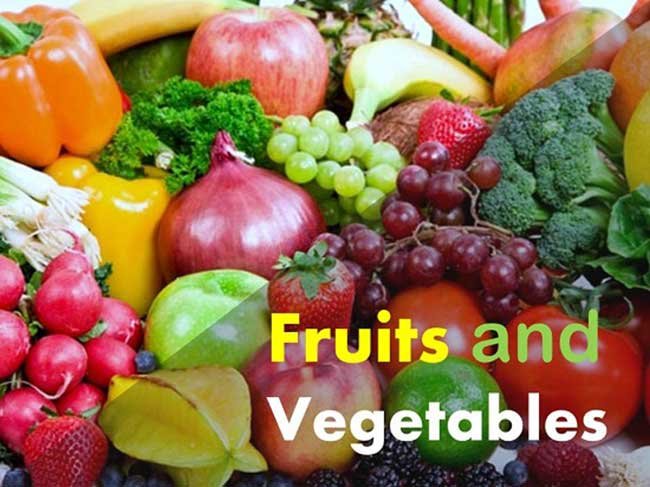
We normally know that fruits and vegetables are good for our health, however, we are not familiar with the difference between fruits and vegetables. In terms of taste, shape, and nutrition, there are many differences between fruits and vegetables.
Fruits and vegetables are categorized from both culinary and botanical perspectives.
In the Botanical way, vegetables and fruits are classified relying on the part of the plant.
Read More: Health Benefits of Pomegranate: This Fruits Fight against Cancer, Arthritis, Type 2 Diabetes, Heart Disease, and More. Read how?
Generally, a fruit grows from the plant’s flower, whereas the other parts of the plant are categorized as vegetables. Fruits hold seeds, whereas vegetables contain stems, roots, and leaves.

From a culinary view, Fruits and vegetables are categorized depending on their taste.
Normally fruits have a tart or sweet taste. You can use them in juices, desserts, or snacks.
Vegetables contain a mild or salty taste and are commonly eaten as the main course or as a part of a side dish.
In a culinary view, you may have a good concept of which foods are regarded as fruits and vegetables.
But, there are some plants that are technically fruits, though they’re regularly categorized as vegetables owing to their taste.
Tomatoes are popular and are debated as an example of this. Under the US customs regulations- the American Supreme Court ruled in 1983 that tomatoes should be categorized as vegetables instead of fruits.
In the Botanical view, tomatoes are suitable as a fruit. But, they’re still mentioned as vegetables owing to their flavor.
These are the types of fruits that you may mistake saying vegetables like:
- Avocados
- Winter squash
- Peppers
- Peapods
- Pumpkins
- Cucumbers
- Eggplants
- Olives
- Zucchini
In the same way, you may consider a vegetable to fruit.
However, naturally, some vegetables contain more sweet flavor than other fruits, during making in pies, desserts and baked goods.
Like rhubarb pie is a well-known dessert with a strong taste.
Although rhubarb is regarded as a fruit, technically it is a type of vegetable that comes from the plant stalk.
Sweet potato pie is one more traditional Thanksgiving dessert in the US.
Although it has a sweet flavor, they are actually a category of root vegetable, not a fruit.
Read More: Health Benefits of Passion Fruits: A Passion Fruit can Vanish 9 Health Problems – See how!
In the same way, candied yam is a baked dish, a type of tuber. Other vegetables, which contain sweet flavor naturally like carrots, beets, turnips, and rutabagas.
Vegetables and fruits may have many nutritional connections. They are rich in fiber along with antioxidants, minerals, vitamins, and other plant compounds. Naturally, Vegetables and fruits are also low in fat and sodium.
You may want to get a more sweet taste. Fruits contain a higher volume of natural sugar and calories than most types of vegetables.
A cup of apples has 13 grams of sugar and 65 calories, whereas a cup of broccoli contains 2 grams of sugar and 31 calories.
If you compare fruits and vegetables, you will see, some types of fruits hold more fiber content than the vegetables in each gram.
Every 100 grams fruit may contain about 2-15% of fiber content, whereas leafy vegetables may contain 1-4% of fiber.
The water content is also varying. Leafy vegetables may have 85–95% of water content, whereas fruits hold somewhat less about 62–88%.
There are particular nutrient differences among many types, also.
Here is some nutritional value to see:
Tubers:
High in fiber as well as a great source of beta-carotene, vitamin C, B vitamins, and potassium.
Citrus Fruits:
These types of fruits are High in antioxidants, vitamin C, folate, and beta-carotene that could give you the protection from degenerative disease.
Cruciferous Vegetables:
This type of vegetable Contains glucosinolates compounds, which have been directly connected to stop cancer.
Berries:
These fruits are full of anti-inflammatory and anthocyanins compounds that are able to decrease oxidative pressure and improve heart health.
Leafy Greens:
A great source of carotenoids like lutein can decrease the risk of cancer, stroke and heart disease.
Keeping a combination of fruits and vegetables in your diet will confirm that you’re getting different nutrients.
Read More: Health Benefits of Corn: This Grain can Control 14 Diseases. Read How?
There are many studies recorded on eating fruits and vegetables on health.
A study found that eating 3 servings of fruits and vegetables can lower the risk of heart ailment by 70%.
For the reason that fruits and vegetables are high in fiber but low in calories, they help you keep your weight in control.
A study was conducted by 133,000 people over 24-years.
It revealed that those people increased their fruits and non-starchy vegetable eating, their weight decreased.
If you Increase your fiber eating with vegetables and fruits, it will decrease the possibility of cancer.
Many studies have found that higher fruit and vegetable eating is connected to let down the possibility of colorectal cancer.
Ultimately, eating fruits and vegetables can bring benefits to your blood sugar level.
These foods’ fiber slows down the absorption of sugar for keeping blood sugar levels stable.
Many studies have proven that increasing the eating of vegetables and fruits can really result in decreasing the risk of different diabetes types.







